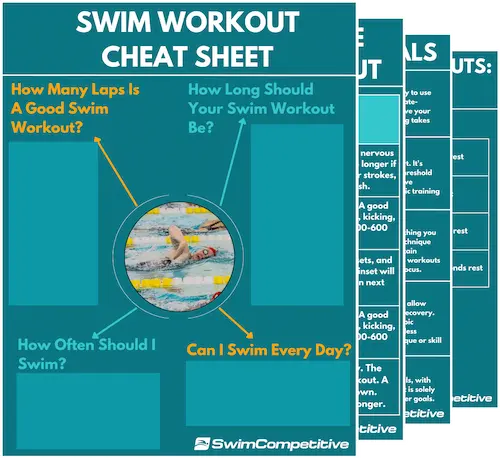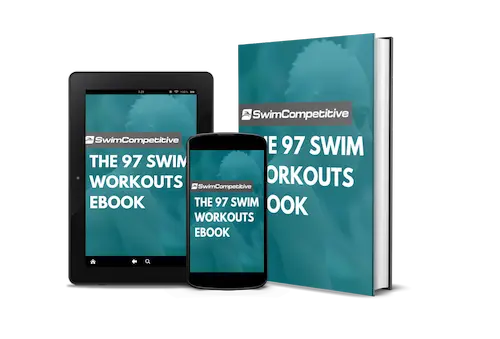Think quick: Are the foods you eat every day contributing to your swimming performance?
If your answer is no or you are unsure, you are not alone. Many swimmers lack the knowledge of foods they should be eating- or not eating- to boost their swimming performance.
That’s okay— you’re only moments away from learning about the best foods for swimmers to fuel your training and recovery, which foods swimmers should avoid, and more.
17 Foods for Swimming to Supercharge Your Performance — the Superfoods
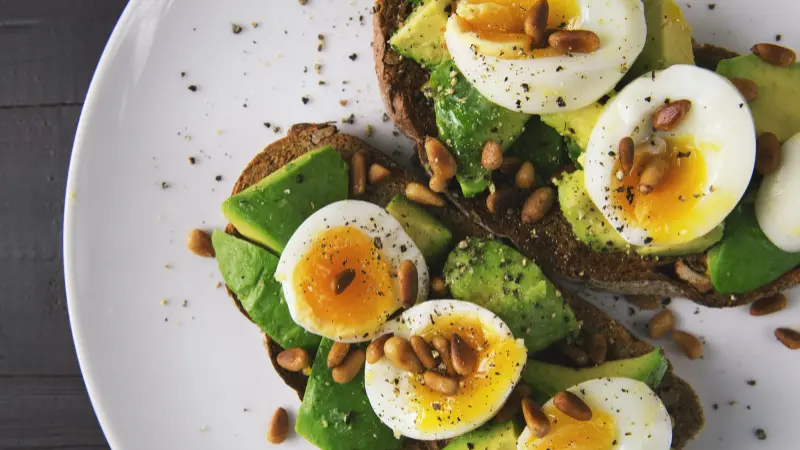
Swimmers should eat food high in carbohydrates and calories to fuel their training and workouts. Also, make sure to include foods rich in protein, healthy fats, and omega-3 fatty acids. Minerals, vitamins, fluids, and electrolytes further play an essential role in keeping you healthy, recovering, and in swimming performance.
Below, in no particular order of importance, is a list of foods for swimmers considered to be superfoods in terms of assisting with physical performance and recovery.
Here are some superfoods for swimmers-
- Oats
- Beets
- Bananas
- Milk
- Sweet potatoes
- Whey
- Chai Seeds
- Eggs
- Walnuts
- Coconut
- Quinoa
- Oranges
- Salmon
- Chickpeas
- Kale
- Apples
- Spirulina
Oats: Carbs and Calories
If you are a swimmer, carbohydrates are your best ally— and you should eliminate the idea that they are bad for you. Not all carbohydrates are equal, though, and some should be avoided.
Oatmeal, however? It’s one of the healthiest sources of carbohydrates out there. According to the Journal of Food Science and Technology, oats are also high in protein, roughly 11-15%.
Apart from being a great source of carbs and protein, oats contain many vitamins, minerals, and antioxidants. This keeps you healthy and aids recovery.
Furthermore, research suggests oats may reduce blood sugar and lower your risk of heart disease by reducing cholesterol.
However, one downside to oats is that it’s very filling due to its high fiber content- potentially a bad thing for swimmers who have to eat a lot to meet daily calorie goals. That said, using the raw oats in shakes and meals is an easy way to make it less filling.
Oats are packed with nutrients and calories. Every 100 grams of oats contain 389 calories, 66.3 grams carbohydrates, 16.9 grams protein, 6.9 grams fat, 10.6 grams fiber, and 0 grams sugar.
Beets: Natural Endurance Booster
Research has shown beetroot increases physical performance factors such as endurance and oxygen uptake, also known as VO2 max.
In one study published in the Journal of the Academy of Nutrition and Dietetics, runners who consumed beets an hour before a 5km race were 5% faster during the last 1.8km of the race.
Another study even showed beetroots to increase endurance by up to 14%. Other benefits also included lower blood pressure and increased tolerance to exercise.
But what is it that makes beetroots so potent?
Beets are incredibly high in nitrates (NO3), which positively affects exercise performance, as suggested by the research.
Consuming beets as part of your daily diet could help boost endurance and exercise performance delivering more significant results from your training in the long term.
You can enjoy beets as beet juice, bottled beet, steamed halves, or grill foiled-wrap halves. I prefer the beet juice, but expect your urine to be colored slightly orange/red. The taste of the juice will also take some time to get used to.
That said, beetroot extract has also been shown to increase performance making beet supplements and powders a viable option as well.
For the best results, Dr. Stephen Lane recommends a 24-hour preload prior to your race. The day prior he takes a dose at lunchtime and a dose in the evening. Then on the day of the event, he recommends taking a dose 3 hours before your event.
A dose typically consists of 500ml raw beet juice.
Besides their endurance-enhancing effects, beets also contain decent amounts of carbohydrates— 10 grams of carbs per 100 grams raw beet. They are also rich in vitamins, minerals, and antioxidants.
Bananas: Easy Carbs and Cramp Buster
Bananas are tasteful and a great form of carbohydrates, potassium, and vitamins B6 and C.
One large banana (136 grams) contains 121 calories and 31 grams of carbohydrates.
Bananas can also assist with hydration (a banana is 75% water). That said, you should still consume plenty of water before, during, and after swimming.
This makes them a perfect pre- or post-workout snack and an easy way to get in extra calories throughout the day.
Bananas are commonly believed to help with cramps.
Although research has not shown them to reduce cramping, generalized muscle cramps are associated with low electrolytes such as potassium, which bananas contain plenty of and will help increase, especially if you are in a potassium deficit.
Milk: Where Carbohydrates Meet Protein
Traditional dairy milk is still the top pick for athletes with the rise of alternative milk such as soy, almond, rice, and even hemp.
Milk is high in carbohydrates and protein, with 1 cup (approximately 250ml) containing 12 grams of carbohydrates and 8 grams of protein.
This makes it a perfect post-workout food for swimmers.
Why exactly? Well, carbohydrates and proteins consumed together are more efficient at repairing muscle than consuming them separately.
If you want to switch up the taste, low-fat chocolate milk is also a great option.
Unfortunately, milk has recently been given a bad wrap by the health-conscious community, with many claiming it to be inflammatory and causing stomach upset.
While it’s true that milk can cause an upset stomach and bloat in lactose-intolerant individuals, you don’t have to worry about this if you don’t suffer these symptoms.
In terms of inflammation, most research suggests that dairy products (such as milk) don’t promote inflammation— and may even reduce it.
Sweet Potatoes: Delicious Carbs, Potassium, and Vitamins
When it comes to taste, sweet potatoes are high on the list.
In terms of nutrients, they contain a decent amount of carbohydrates- roughly 20.7 grams carbs per 100 grams- and they are also rich in antioxidant vitamins such as vitamin A and C.
Sweet potatoes also contain other minerals essential for swimmers’ muscle function, such as potassium, iron, manganese, and copper.
Furthermore, research has shown sweet potatoes reduce blood pressure as well.
Whey: Protein-Packed
Whey protein is a supplement commonly made from dairy milk, but other plant-based protein supplements are also available nowadays.
Whey is quickly absorbed by muscles ensuring they can rebuild and recover as quickly as possible.
Whey is one of the purest forms of protein containing all of the crucial amino acids. Additionally, it’s low in fats, carbohydrates, and cholesterol.
While low carbs aren’t ideal for swimmers, you can easily mix whey with milk to create an excellent post-workout recovery snack extra high in protein.
If you are a swimmer who struggles to get enough protein in your daily diet or just needs some extra, then whey may be the perfect solution for you.
That said, whey protein can be expensive, so if you are already getting a lot of protein from other food sources, it might not be necessary— although potentially convenient.
Whether you decide to add whey protein to your diet, it’s up to you.
Chia Seeds: The Warriors’ Food
Dubbed the warriors’ food by the ancient Aztec warriors and Mayans, chai seeds are one of the most nutrient-dense foods out there, containing a perfect blend of carbohydrates, proteins, and fats.
Chia seeds are also loaded with omega-3s, antioxidants, calcium, and iron.
Every 100 grams of chia seeds contain 486 calories, 42 grams carbohydrates, 17 grams protein, 31 grams fat, and 34 grams fiber.
Additionally, these seeds have hydrophilic properties. This means they can absorb more than 12 times their weight in water, helping you stay hydrated for longer by retaining moisture. They also help regulate the absorption of nutrients in the body.
Use chia seeds in smoothies, as part of salad dressing, muffins, homemade granola, protein bars, or even popsicles and jams.
You can also make your own chia drink using coconut or regular water, or some fruit juice, and 2-3 tablespoons of chia seeds.
Furthermore, it’s recommended to use unprocessed seeds as processing removes the seeds’ natural oils, containing the primary nutrients.
Eggs: Protein Bomb
Eggs are a staple in many top athletes’ diets, and it’s easy to see why- they are cheap, can be cooked in many ways- and most importantly, pack about 6 grams of protein per large egg.
Eggs also contain all eight essential amino acids needed to build and maintain muscle.
You can prepare your eggs in many ways- scrambled, omelet, poached, boiled, and more. They also go well with many other foods.
Tip: Quickly prepare 1 or 2 boiled eggs before training and enjoy with some salt as part of your post-workout snack.
Walnuts: High-Calorie Anti-Inflammatory
Packing 654 calories per 100 grams, walnuts are the perfect food for swimmers who need help getting in some extra calories. Every 100 grams contain about 14 grams carbohydrates, 15 grams protein, and 65 grams fat (but the healthy sort).
Walnuts are also high in fiber, B-vitamins, and antioxidants such as vitamin E. They contain more omega-3s than any other nut type and have anti-inflammatory nutrients good for bone health.
Research has also shown walnuts decrease LDL cholesterol (the bad type) by 5-9%.
Furthermore, swimmers can enjoy walnuts as part of a mixed salted nut snack that can be bought at the grocery store, which will provide extra sodium to your diet.
Sodium plays a crucial role in many areas, such as cognitive function, nerve impulse transmission, and muscle contraction, but most importantly, it helps maintain your body’s fluid balance.
This is important for boosting blood volume, which reduces the strain on your cardiovascular system while it transports oxygen to muscles and disperses heat to cool you down during hard swimming workouts.
Coconut: Nutrient Versatility
You can add coconuts to your diet in many ways, including coconut oil, raw coconut, coconut chips, and even as part of cooking and baking recipes- but perhaps the most beneficial for swimmers is coconut water.
Why coconut water? It’s packed with potassium, sodium, and other electrolytes- just like a sports drink.
Professional tennis player, John Isner, is an avid supporter of coconut water for athletic performance. He claims it helped him stay on his feet during his 11-hour Wimbledon tennis match, where he eventually won.
It is super hydrating and has kept me going in long matches and prevented me from cramping even in the hottest and most humid conditions.
– John Isner.
Keep in mind, coconut water should not be seen as a replacement for traditional water as that should still be your primary source of hydration. However, additional hydration sources may benefit swimmers during longer workouts.
That said, it’s also debatable whether or not coconut water is worth it as sports drinks like Gatorade pack more nutrients and calories while also being cheaper.
However, if you enjoy coconut water, it could be an excellent way to spice up your hydration every now and then.
Quinoa: Healthy Carbs
Known as a pseudocereal, quinoa is a nutritious seed prepared and eaten like a grain.
Quinoa is a good source of carbohydrates, with cooked quinoa consisting of about 70% carbs. It also contains moderate amounts of protein and fiber.
Every 100 grams of cooked quinoa contains 120 calories, 21.3 grams carbohydrates, 4.4 grams protein, 1,9 grams fat, and 2.8 grams fiber.
Quinoa also provides health benefits due to its many minerals and plant compounds. These compounds have been linked to improved blood sugar management and heart health.
Quinoa is also popular among health-conscious consumers since it is gluten-free.
Swimmers can try this food as part of their breakfast or use it as a pre- or post-workout snack.
Oranges: Immune Boosting Carbohydrates
Oranges are one of my favorite citrus fruits— and I’m sure many will agree they are delicious.
Raw oranges pack about 47 calories and 12 grams of carbohydrates per 100 grams. They are also rich in vitamin C, potassium, and antioxidants. Vitamin C plays a vital role in immune function and keeping you healthy.
Swimmers can also try out orange juice. It’s similar in nutritional value but will be easier to consume in large quantities if you are looking for some extra calories.
That’s because orange juice is lower in fiber and is in liquid form.
Research has also shown that vitamin C, as found in oranges, may improve iron absorption from other foods you eat.
Iron is essential for growth and development- in other words, muscle recovery. Iron is also used to produce hemoglobin and myoglobin. Hemoglobin helps carry oxygen in red blood cells to all parts of your body, while myoglobin provides oxygen to your muscles.
Salmon: Recovery and Protein from the Ocean Depths
Loaded with calories and high-quality protein, it’s easy to see why salmon is viewed as a superfood for athletes. Every 100 grams contain 208 calories and 20 grams protein.
This fish also contains lots of essential omega-3s and high amounts of vitamin B12 and B6.
Salmon is known for reducing inflammation because of its high omega-3 content, helping swimmers recover more quickly after swimming and land-based workouts.
Research has also shown that eating salmon can reduce cardiovascular risks such as heart attack, stroke, and high blood pressure.
It’s not necessary to eat salmon daily, but if you enjoy it and have it available, you can consider making it a part of your meal plan and including it in dinners or other meals.
Chickpeas: Plant Protein and Carbohydrates
Food like beans are well known for being high in protein, but chickpeas combine this with a rich base of carbohydrates, making them perfect for swimmers. They are also relatively high in calories helping to keep your body fueled.
Cooked chickpeas contain 164 calories, 27.4 grams carbs, 8.8 grams protein, 2.5 grams fat, and 7.6 grams fiber per 100-gram serving.
Additionally, chickpeas are high in vitamins and minerals like iron, phosphorus, and B vitamins.
Swimmers can also try canned chickpeas if they want to add some extra sodium to their diet.
As discussed earlier, sodium is an essential nutrient for athletes and is frequently lost through sweating.
Kale: Vitamin Rich Inflammatory Regulator
Like many vegetables, Kale isn’t the highest calorie food out there. Nevertheless, it still has a good nutrient density containing 49 calories, 9 grams carbohydrates, 4.3 grams protein, and 0.9 grams fat per 100 grams.
Kale is also rich in vitamin A, K, and B6 and minerals iron and calcium. Furthermore, its high antioxidant content helps regulate your body’s inflammatory process.
While I wouldn’t rely on kale to bring in the calories, adding it to meals as part of a salad, for example, will help to keep you healthy and keep inflammation under control, ensuring you stay on top of your swimming.
Apples: One a Day Keeps Your Training Underway
As the saying goes: an apple a day keeps the doctor away- or in other words- you don’t have to worry about missing swim training by getting unnecessarily sick.
What the saying missed, however, is that apples are also a good source of carbohydrates. Every 100 grams contain 52 calories and 14 grams of carbohydrates, making it a good food for swimmers to snack on throughout the day.
While apples contain many vitamins and minerals, they are only in small amounts.
That said, apples are rich in Vitamin C, antioxidants, and fiber.
Research has also linked apples to improved blood sugar management, cardiovascular health, and reduced cancer risk.
Spirulina: Natural Protein Powerhouse
Slightly unconventional and less well-known is spirulina. Boasting a 60% protein content while packing high levels of vitamins, calcium, and omega 3 and 6, this stuff is truly a superfood.
Every 100 grams pack 290 calories, 24 grams carbohydrates, 57 grams protein, and 8 grams fat. Spirulina is also high in sodium and potassium.
However, it’s best to include spirulina in smaller amounts as part of smoothies or shakes as eating it alone probably won’t be very tasteful. You can also mix it with water or juice if you’d like. That said, smaller amounts (1 tablespoon) will still pack up to 4 grams of protein.
But what exactly is this stuff?
Spirulina is a biomass of cyanobacteria. While that might not sound very appetizing to some, it is just another plant-based food source and is entirely safe to consume by humans.
Combine spirulina with some fruit juice (like orange juice), and you’ve got a nutritious vitamin and sodium-rich post-training snack when you hop out of the pool after swimming.
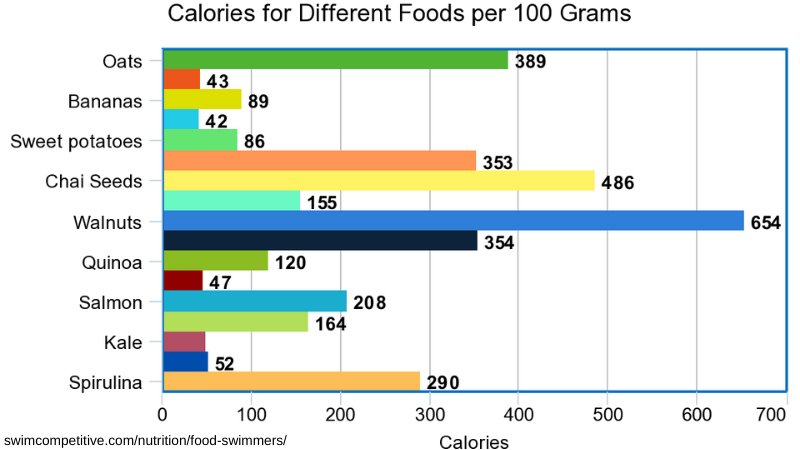
Do You Want to Make Every Lap Count?
Stop wasting your time in the pool feeling lost and doing directionless swim workouts, and start training effectively! Our ebook contains 97 structured and goal-orientated swim workouts to help you become a better, faster, and fitter swimmer. Whether you’re a complete beginner or a seasoned pro, there are a multitude of workouts for every type of swimmer.
Other Good Food for Swimmers
In no particular order, here are some other foods to include in your diet for ideal swimming performance and recovery. These foods aren’t necessarily “superfoods” and may be slightly more processed, but are still healthy and nutritious.
Good food for swimmers-
- Whole grains like brown rice, pasta, and bread.
- Chicken breast.
- Turkey.
- Ground beef.
- Steak.
- Pork.
- Fish like hake and tuna.
- Dried fruits.
- Regular potatoes with skin.
- Yogurt.
- Other nut types like almonds, cashews, etc.
- Other types of beans like lentils and peas.
- Muesli or granola.
- Rice cakes.
- Vegtables in general: spinach, carrots, tomato, etc.
- Fruits in general: blueberries, watermelon, grapes, strawberries, etc.
- Homemade English muffins (for the calories!).
What Foods Should Swimmers Avoid?
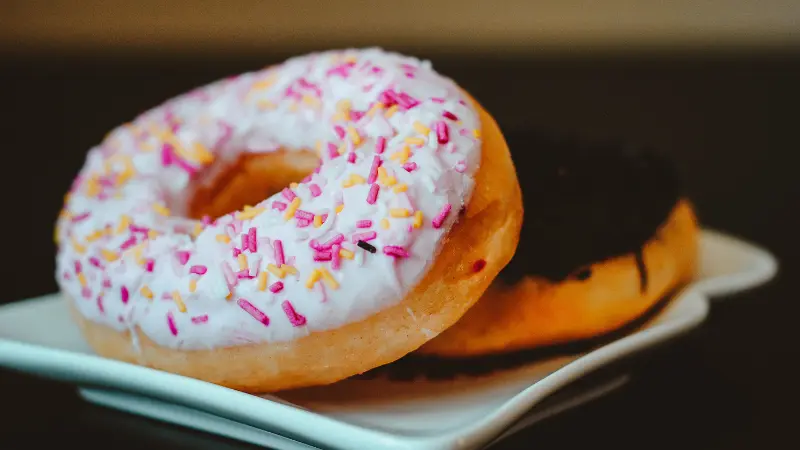
While it’s true that swimmers, especially elite swimmers who train a lot, can get away with eating unhealthy foods- at least aesthetically- it’s best to steer away from certain foods that may impact your training performance.
You should keep anything that is generally considered unhealthy out of your diet. That said, this doesn’t mean you have to sacrifice everything you enjoy.
For example, if you like pizza or burgers, try making your own homemade variations instead, as these will be much healthier compared to takeaways or restaurants where foods like this are often unnecessarily oily or may contain artificial ingredients.
Here are some foods swimmers should avoid-
- Spicy and fatty foods: Can cause stomach discomfort, bloating, and cramps. However, not all fats are bad, but try to get your fats from healthy sources like nuts, fish, eggs, and avocados.
- High sugar foods: Apart from being unhealthy, sugar can cause a crash in performance when blood sugar levels drop. Avoid candy, chocolates, and pastries like cake and donuts. Particular “healthy” foods like granola bars may also be high in sugar. Try sticking to simple sugars such as those found in sports drinks and fruit juice as the body can easily consume and convert these to glucose used for energy.
- High fiber foods: Fiber is healthy and should be included in your diet. However, it might make you feel unnecessarily full and “heavy” if you have it right before training. That said, time your meals and snacks correctly, and you won’t run into this issue.
When Should Swimmers Eat?
According to Brue Baker, a fitness expert, swimmers should have several smaller meals per day (up to 7) as they have to eat a large number of calories to fuel their training. Large meals will make swimmers feel lethargic and will limit performance.
I recommend having meals at regular times every day. For example, you might have a light snack before early morning practice, breakfast at 7 am after that, another meal at 10 am, and so on. You can plan it as it suits you.
However, nutritional timing before and after your workouts is critical as it will play a role in fueling your training and helping you recover properly.
You want to have a meal 2-3 hours before swimming (unless it’s early morning practice). Also, include 16 ounces/ 500ml of fluids with your meal. Then 30-60 minutes before your workout, you want to have a light snack and 8 ounces/ 250ml of fluids.
Both your pre-workout meal and snack should be mainly carbohydrates with small to moderate amounts of low-fat protein.
During your workout, you also want to stay hydrated.
For workouts lasting an hour or less, water alone is enough. For workouts longer than an hour, include a sports drink as well.
Make sure to drink 4-6 ounces/ 100-200ml of fluid every 10-20 minutes while exercising.
After training, you want to eat another snack and meal.
You should have your snack within 30 minutes of finishing your workout. Your snack should combine carbohydrates, proteins, and fluids- about 8 ounces/ 250ml of fluid.
You should eat your post-workout meal within 2 hours of eating your snack. Your meal should be at least 50% carbohydrates and include plenty of protein, healthy fats, and vegetables/ fruits.
How Much of Each Macronutrient Should Swimmers Eat?
Now that you know what to eat and when to eat, it may be helpful for you also to know how much of each nutrient you should consume daily.
Apart from your pre-swimming meal, which should be primarily carbohydrates, here are some general guidelines from the American Dietetic Association regarding how many carbohydrates, proteins, and fats swimmers should consume daily:
- Carbohydrates: 2.3 to 3.6 grams of carbohydrates per pound of body weight/ 5 to 8 grams of carbohydrates per kilogram of bodyweight.
- Protein: 0.55 grams to 0.8 grams of protein per pound of bodyweight/ 1.2 to 1.7 grams of protein per kilogram of bodyweight.
- Fats: 0.45 grams of fat per pound of bodyweight/ 1 grams of fat per kilogram of bodyweight.
I recommend swimmers who do additional weight training/ dryland training to stick in the upper ranges of the protein recommendation.
You may even require slightly more protein (up to 1 gram per pound of bodyweight / 2.2 grams per kilogram of body weight) for muscle to be built and repaired effectively.
Swimmers are also recommended that their diet consists of 60% carbohydrates, with protein and fats making up the remaining percentages.
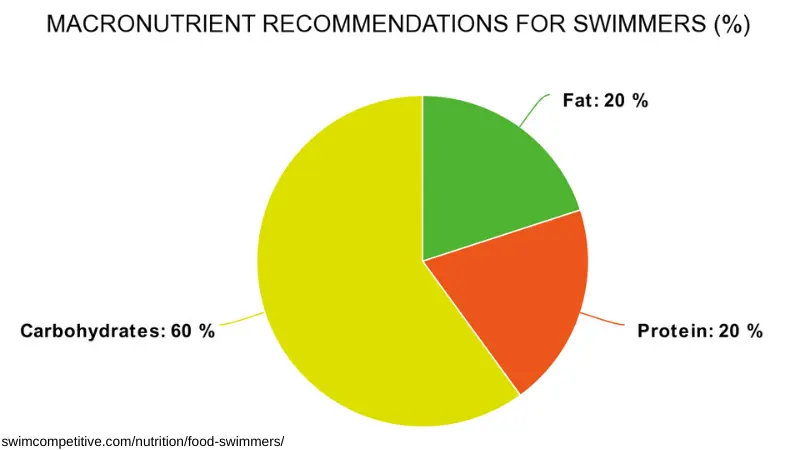
Case study 1: Nutritional needs for a 160-pound swimmer based on the guidelines by the American Dietetic Association.
(These needs may vary depending on how much the swimmer is training. You’ll have to consult with a registered dietitian to determine this most accurately.)
Nutritional needs 160-pound swimmer (example only):
- Carbohydrates: 576 grams.
- Protein: 128 grams.
- Fat: 72 grams.
- Total calories: 3464 calories.
For this example, the upper ranges of the recommendations were used.
Calculations for case study 1:
- Carbohydrates: 160 x 3.6 = 576 grams.
- Protein: 160 x 0.8 = 128 grams.
- Fat: 160 x 0.45 = 72 grams.
- Calories: (576 x 4) + (128 x4) + (72 x 9) = 3464 calories.
Calories are calculated assuming that carbohydrates and protein are roughly 4 calories per gram, and fats are about 9 calories per gram.
You could also use an online tool like a BMR calculator to determine your daily calorie needs. See below:
Case study 2: Determining nutritional needs for an 80 kg male, 185 cm tall, doing 2+ hours of exercise daily using an online BMR calculator and recommendations from the American Dietetic Association. (Recommended method).
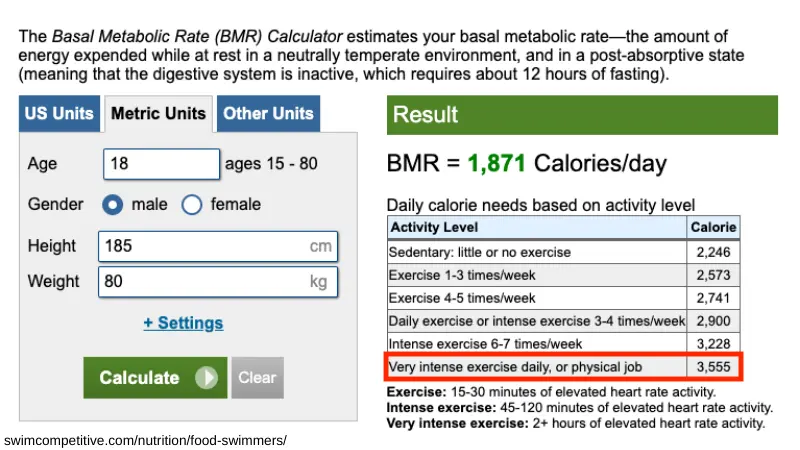
Once you have your calorie number, you need to break the calories down into percentages, say 60%, 20%, 20% as recommended.
Once you have the percentages, you can convert them to grams of carbohydrates, fats, and protein by dividing them by the average caloric value of each.
As mentioned 4 calories for carbs and protein and 9 calories for fats.
Nutritional needs for 80kg male, 185cm tall (example only):
- Calories (maintain weight): 3555.
- Carbohydrates (60%): 533.25 grams.
- Protein (20%): 177.75 grams.
- Fats (20%): 79 grams.
Calculations for case study 2:
- Carbohydrates: 3555 x 0.6 ÷ 4 = 533.25 grams.
- Protein: 3555 x 0.2 ÷ 4 = 177,75 grams.
- Fat: 3555 x 0.2 ÷ 9 = 79 grams.
There are different BMR calculators out there, but these are the 2 that I’ve found to be the most accurate and user-friendly:
- BMR Calculator by Calculator.net (Simple and easy to use).
- Body Weight Planner by the National Institue of Diabetes and Digestive and Kidney Diseases (More accurate and recommended to use, but more advanced and has additional metrics).
Gaining and Losing Weight for Swimmers
A BMR calculator gives you an estimate of how many calories your body requires in a day.
This means you’ll maintain your current weight if you eat that amount of calories, commonly called your “maintenance calories.”
However, if you want to gain weight or lose weight, you’ll have to adjust your calories.
You want to eat 300-500 calories above your maintenance calories to gain weight. This is called a “calorie surplus.”
A calorie surplus is recommended when you want to build muscle and become stronger and more powerful.
For our example, in case study 2, that would mean the swimmer needs to eat 3855-4055 calories per day to gain weight.
You want to eat 300-500 calories below maintenance calories to lose weight. This is known as a “calorie deficit.”
The same thing applies to our example in case study 2. The swimmer would then need to eat 3055-3255 calories per day to lose weight.
Related: 9 Swim Workouts to Lose Weight.
A Word of Caution Regarding Weight Loss for Swimmers
When adjusting calories for weight loss, it’s important to be aware that you might lose strength. Swimming performance may also be negatively affected as your body isn’t receiving enough energy and will be breaking down fat tissue to supply energy to itself.
I should also note if you are already lean or you lose weight too quickly, your body may start to break down muscle as well.
To preserve muscle and support better sports performance, you should aim to lose weight at a slower rate.
It’s recommended that athletes such as swimmers lose weight at a rate of about 0.5 kg/ 1.1 pounds per week and do so in the off-season or during periods of less intense training as it’s challenging to lose body fat and reach peak fitness simultaneously.
Other things you can do to minimize muscle and performance loss are eating more protein, spreading protein evenly throughout the day, refueling well after workouts, and doing strength training if you aren’t already.
Once you’ve reached your weight loss goal, you should gradually increase calories again instead of directly going back to normal.
This will give your body time to adjust its metabolism and hormone levels, preventing you from gaining back the fat you’ve lost.
Apps to Help You Track Nutrients
Once you know your goals (maintain, lose, or gain weight) and you’ve determined your daily nutritional needs, you need a way to track your calories and macronutrients to ensure you stay on track.
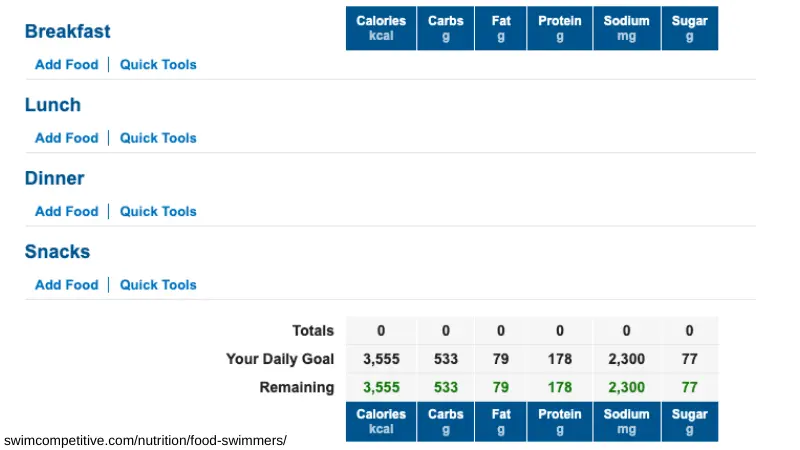
There are many calorie tracker apps to choose from, but my favorite is MyFitnessPal. It’s free and has an extensive database of foods and meals. You can also scan barcodes on products to get the nutritional value.
There is a premium version available, but you don’t need it.
Then you add those foods to your different meals (breakfast, lunch, dinner, snacks), and the app will tell you how many calories you still have to eat and how many carbohydrates, protein, and fat you’ve had.
I recommend weighing and measuring your food as well to get the most accurate numbers.
You can also set calorie and macronutrient goals. So for swimmers, you’d set your calories to whatever number the BMR calculator gives you and then set carbohydrates to 60%, protein to 20%, and fats to 20% as well.
The app will then adjust the numbers and tell you how much of each nutrient you need to eat per day.
